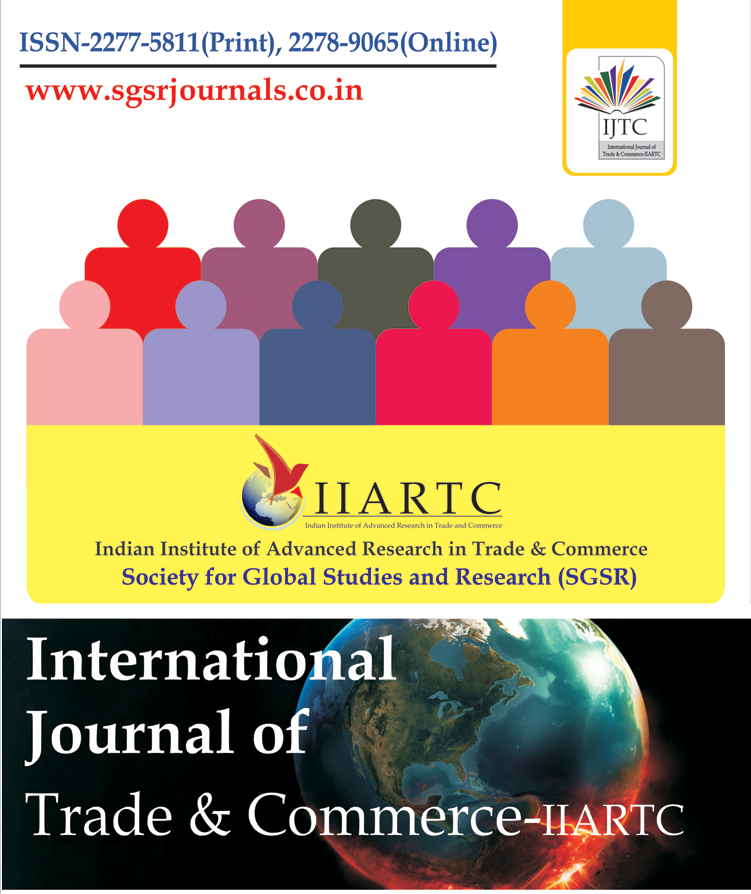Home ⇨ International Journal of Trade & Commerce-IIARTC

International Journal of Trade & Commerce-IIARTC
Impact Factor (IF):5.135 (COSMOS), IF:7.249 (ISRA), IF:3.721 (ISI)
ISSN:2277-5811 (P), ISSN:2278-9065 (O)
Frequency: Half Yearly
Relevance and Importance of Tibetan Diaspora in India
Tibet covers about 2.5 million sq km, vast, but 75% of this is primarily inhabited because of extreme climate. It is located between 28- and 38-degrees North parallels and 78 and 103 East meridian. Tibet is appropriately called the 'Roof of the world" since it is the highest and the broadest plateau globally, ranging between 16000 and 11000 ft in height. For most of the year, mountains remain covered by a thick mantle of snow, with the lowest temperatures touching minus 40 degrees Celsius in the winter. The area is rich in metals and minerals like gold, iron, copper, coal, tungsten, uranium, manganese, tin, etc., which can make the country extremely rich if adequately exploited. Tibet is closely associated with India as its royal dynasty started from a descendent of Magadha, exiled from India. He became the ruler of Yarlung in 127 BC and was named Nyatra Tsangpo. The Indo Tibetan relationship had always been cordial. Buddhist spiritual leader Shantarakshita established the monastery "Samy's Migyar Lhungi Dubpai Tsukla-Khang" at the request of then King Trisong Delson. However, the Sino-Tibetan relations were always bitter. Tibetans defeated China decisively in the year 763 and dominated it for almost 20 years there. However, after several reversals, China emerged as a strong power and claimed Tibet to be an integral part of the Peoples Republic of China. Tibetan Government has been in exile in India since 1959. Tibet always served as a buffer state between British administered India and China. India provided asylum to a large number of Tibetans and the Dalai Lama in the '50s.
Author:Sanjay Kumar1*, Anil Gorshi 2
Abstract:Tibet covers about 2.5 million sq km, vast, but 75% of this is primarily inhabited because of extreme climate. It is located between 28- and 38-degrees North parallels and 78 and 103 East meridian. Tibet is appropriately called the 'Roof of the world" since it is the highest and the broadest plateau globally, ranging between 16000 and 11000 ft in height. For most of the year, mountains remain covered by a thick mantle of snow, with the lowest temperatures touching minus 40 degrees Celsius in the winter. The area is rich in metals and minerals like gold, iron, copper, coal, tungsten, uranium, manganese, tin, etc., which can make the country extremely rich if adequately exploited. Tibet is closely associated with India as its royal dynasty started from a descendent of Magadha, exiled from India. He became the ruler of Yarlung in 127 BC and was named Nyatra Tsangpo. The Indo Tibetan relationship had always been cordial. Buddhist spiritual leader Shantarakshita established the monastery "Samy's Migyar Lhungi Dubpai Tsukla-Khang" at the request of then King Trisong Delson. However, the Sino-Tibetan relations were always bitter. Tibetans defeated China decisively in the year 763 and dominated it for almost 20 years there. However, after several reversals, China emerged as a strong power and claimed Tibet to be an integral part of the Peoples Republic of China. Tibetan Government has been in exile in India since 1959. Tibet always served as a buffer state between British administered India and China. India provided asylum to a large number of Tibetans and the Dalai Lama in the '50s.




